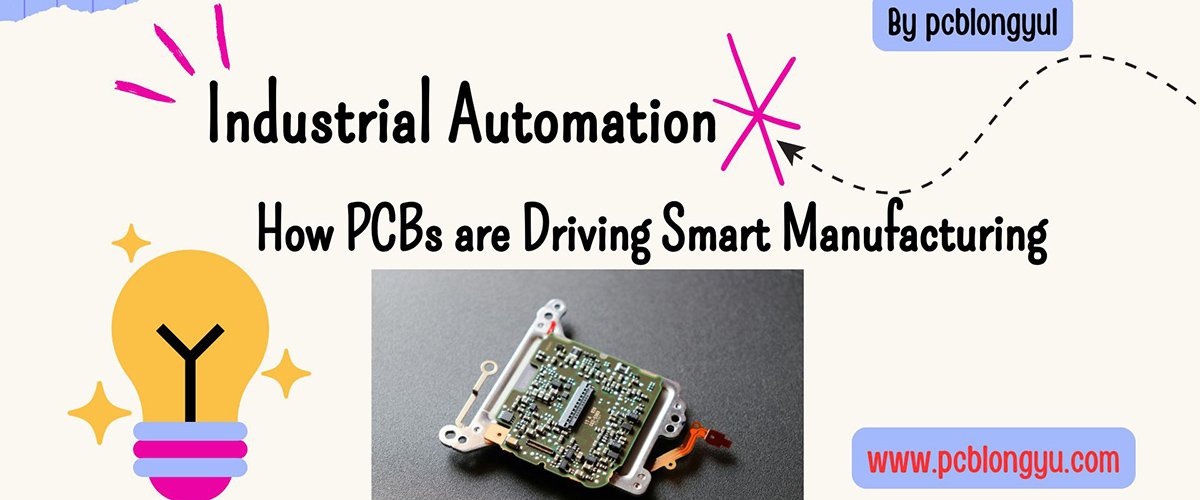The landscape of manufacturing is undergoing a profound transformation, driven by the relentless pursuit of efficiency, precision, and connectivity. This revolution, often termed "Smart Manufacturing" or "Industry 4.0," hinges on the seamless integration of digital technologies into traditional industrial processes. At the heart of this transformation lies the humble Printed Circuit Board (PCB), a critical component powering the sophisticated automation systems that are reshaping factories worldwide.

The PCB: Nervous System of Smart Factories
PCBs are more than just platforms for electronic components; they are the nervous system of modern industrial automation. They enable the complex communication and control required for interconnected machinery, sensors, and actuators. Here's how:
>>> Embedded Systems and Microcontrollers: PCBs house microcontrollers and embedded systems that process data, execute instructions, and control machine operations. These systems are the brains behind automated tasks, from simple conveyor belt movements to complex robotic assembly lines.
>>> Sensor Integration: Smart manufacturing relies heavily on real-time data acquisition. PCBs provide the interface for connecting a vast array of sensors, including temperature, pressure, vibration, and proximity sensors. These sensors provide critical feedback, enabling machines to adapt to changing conditions and optimize performance.
>>> Communication and Networking: PCBs facilitate seamless communication between machines, control systems, and cloud platforms. They enable data exchange through various protocols like Ethernet, Wi-Fi, and Bluetooth, forming the backbone of the Industrial Internet of Things (IIoT).
>>> Actuator Control: PCBs drive actuators, the electromechanical devices that execute physical actions. This includes controlling motors, valves, and robotic arms, enabling precise and automated movements.
The Role of PCB in Industrial Automation
PCBs serve as the backbone of electronic devices, providing the necessary connections and support for industrial automation systems. These boards integrate microcontrollers, sensors, and communication modules to facilitate real-time monitoring and control of industrial processes.
>>> Enhanced Connectivity with IoT
Smart manufacturing relies heavily on the Internet of Things (IoT). Advanced PCBs incorporate IoT modules, allowing seamless data exchange between machines and cloud systems. This enables predictive maintenance, reduces downtime, and enhances overall equipment effectiveness (OEE).
>>> AI and Machine Learning Integration
Artificial Intelligence (AI) algorithms require high-speed data processing capabilities, which are supported by multi-layered and high-density interconnect (HDI) PCBs. AI-powered automation systems can analyze production data, detect defects, and optimize workflows in real time.
>>> Powering Robotics and Automation Systems
Industrial robots rely on sophisticated PCBs for motion control, precision operation, and energy efficiency. These PCBs integrate advanced microprocessors and power management systems, ensuring optimal robotic performance in assembly lines, material handling, and quality inspection.
The Role of PCBs in Key Automation Technologies
>>> Robotics: Advanced robotic systems, crucial for automation, rely on sophisticated PCBs for precise control, sensor integration, and communication.
>>> Automated Guided Vehicles (AGVs): AGVs, used for material handling and logistics, utilize PCBs for navigation, obstacle avoidance, and communication with central control systems.
>>> Machine Vision Systems: Machine vision systems, used for quality control and inspection, rely on high-performance PCBs for image processing and analysis.
>>> Programmable Logic Controllers (PLCs): PLCs, the workhorses of industrial automation, use specialized PCBs for controlling and automating industrial processes.
Data-Driven Automation and Enhanced Efficiency
The data collected by PCB-powered sensor networks is crucial for optimizing manufacturing processes. According to a report by McKinsey, implementing IoT solutions in manufacturing can lead to a 10-20% reduction in maintenance costs and a 10-20% improvement in production output.
>>> Predictive Maintenance: By analyzing sensor data, manufacturers can predict equipment failures before they occur, minimizing downtime and reducing maintenance costs. PCBs enable the integration of vibration sensors and temperature sensors, which provide critical data for predictive maintenance algorithms.
>>> Real-Time Monitoring and Control: PCBs enable real-time monitoring of production processes, allowing operators to identify and address issues immediately. This improves efficiency and reduces waste.
>>> Adaptive Manufacturing: Data-driven automation allows machines to adapt to changing production demands and optimize their performance. This flexibility is essential for meeting the increasing demand for customized products.
Challenges and Future Trends
Despite the advancements in PCB technology, challenges remain in industrial automation. The high cost of advanced PCB manufacturing, issues related to electronic waste management, and cybersecurity threats in connected manufacturing environments are key concerns. Additionally, ensuring interoperability between different automation systems remains a hurdle.
Looking ahead, the future of PCB-driven automation will see a rise in flexible and biodegradable PCBs, enhancing sustainability. The integration of 5G technology will further improve real-time data exchange, boosting manufacturing efficiency. Moreover, AI-driven design automation will revolutionize PCB production, reducing development time and improving reliability.
While PCBs are vital for smart manufacturing, challenges remain.
>>> Miniaturization and Integration: As manufacturing processes become more complex, there is a growing demand for smaller and more integrated PCBs.
>>> Ruggedization and Reliability: Industrial environments often expose PCBs to harsh conditions, requiring robust designs and materials.
>>> Cybersecurity: The increasing connectivity of industrial systems raises concerns about cybersecurity. Securing PCBs and the networks they connect to is crucial.
Looking ahead, the future of industrial automation will be shaped by advancements in:
>>> Flexible PCBs: Flexible PCBs will enable the integration of electronics into curved and irregular surfaces, opening up new possibilities for sensor deployment and device design.
>>> 3D-Printed PCBs: 3D printing of PCBs will enable faster prototyping and customized designs, reducing time-to-market.
>>> Artificial Intelligence (AI) and Machine Learning (ML): AI and ML algorithms will analyze sensor data and optimize manufacturing processes, further enhancing efficiency and productivity.
PCBLongyu combines technological excellence, uncompromising quality, and customer-focused agility to deliver PCBs that power innovation across industries. Whether you’re developing cutting-edge IoT devices or mission-critical aerospace systems, PCBLongyu’s expertise ensures your products meet the highest standards of performance and reliability. By choosing PCBLongyu, you’re not just selecting a manufacturer—you’re partnering with a leader committed to advancing your success in a competitive global market.
Contact PCBLongyu today to discuss your project requirements and experience the difference of world-class PCB manufacturing.